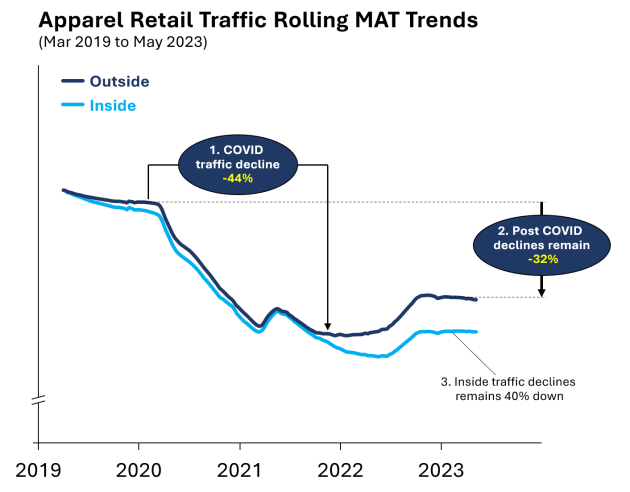Increasing Fitting Room Conversion has a higher impact on sales than increasing Sales Conversion at the same rate. The challenge for all apparel retailers is to measure the use and return from their fitting rooms, as well as the shop floor. Australian in-store traffic optimisation company Kepler Analytics explains more.
Fitting rooms serve as transformative portals where customers can gauge the perfect fit, fabric feel, and overall allure of a garment. Fitting rooms afford consumers a private sanctuary to experiment, fostering confidence and reducing purchase anxiety.
Measuring Fitting Room usage can be a vital tool for apparel retailers aiming to boost sales and clear excess inventory. Unlocking the full potential of fitting rooms can be a game-changer for apparel & footwear retailers, and anyone with key in-store demonstration points.
With 32% less traffic than pre-pandemic levels walking past apparel retail doors, and even less traffic entering stores, the need to effectively engage all traffic that enters is paramount. Add increased economic headwinds, landlord difficulties, overstocks and staff constraints and it can get intense. Add to this the enduring decline in passerby traffic in shopping precincts, and retailers have vastly more challenging circumstances, and less scope to extract themselves from it than ever before.
Research has consistently highlighted that increased fitting room use leads to increased sales through better sales conversion metrics and bigger, more valuable baskets. The impact is significant.
Kepler Analytics, an Australian in-store traffic optimisation company, has studied the results of over 1,500 apparel retailers across Australia which showed an increase in Fitting Room usage will deliver incremental in Sales $ above changes in Sales Conversion alone.
The pandemic reduced Fitting Room usage by almost 20%. Kepler can accurately track actual usage by time of day. Aggregating this data shows that Fitting Rooms across Australia have still not recovered.
Traditional tools such as layout and ambiance of these spaces are crucial. Lighting, full-length mirrors, climate control and comfortable seating can create a welcoming atmosphere that entices customers to spend more time trying on clothes. However, far more data is needed for retailers to make the best use of their Fitting Rooms. Data that is gained simply, unobtrusively, cheaply and without any privacy implications.
Based on analysis of over 1300 apparel retailers in Australia, Kepler has provided the following industry statistics below:
Understanding the sequenced pathway is vital to gaining actionable insights.
- 65% of all retail intentioned store entrants (that is, entrants excluding staff and non-retail intentioned traffic such as delivery drivers) will leave the store without engaging merchandise.
- For each 1% increase in fitting room users, sales conversion will increase by 1.5%. Setting a quantifiable and measurable target to increase Fitting Room usage is the single biggest lever for a retailer seeking strong sales growth.
This product is well-received by retailers. The Head of Product at Kepler Analytics puts it this way:
“We place a sensor to accurately count intentional shoppers in the retail space, one in the fitting rooms, and then one in the point of sale counter. By doing this, we can track the customers’ path to purchase throughout the day, and then most importantly highlight opportunities for growth across all metrics, from sales conversion, and even average basket value and size derived from fitting room usage."
To maximise Fitting Room conversion, all the traditional levers must be respected. But Kepler suggests that there are a number of other levers that can be pulled.
Founder of Kepler David Mah says staff engagement is key.
“One of our longest standing clients has created an incentive scheme for staff based purely on Fitting Room conversion. Staff are rewarded for the effectiveness at directing traffic into these areas. This has directly boosted their sales over several years."
This is just one example of how small changes deliver big results for Kepler clients. It is also about knowing when potential customers are choosing to use fitting rooms.
The decline in viable retail traffic has been accompanied by a movement in when traffic shops. Kepler has noticed a distinct misalignment in Fitting Room usage and sales conversion.
“Fitting rooms are not being used as the sales drivers they are”, says Tom Gleeson, CEO of Kepler. “We are actively working with our clients to identify the patterns of opportunity, surfacing the insights quickly, and adapting resources and executions to deliver more sales, with less expense. And because it is based on powerful data informed insights, it shows rapid results across our client base.”
More sales with less expense, with truly effective, privacy compliant fitting room measurement.
It’s a retailer’s dream come true.







